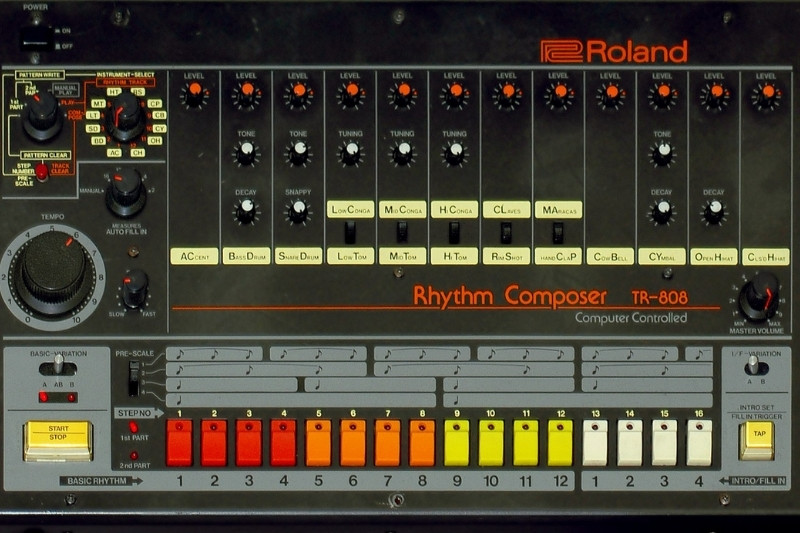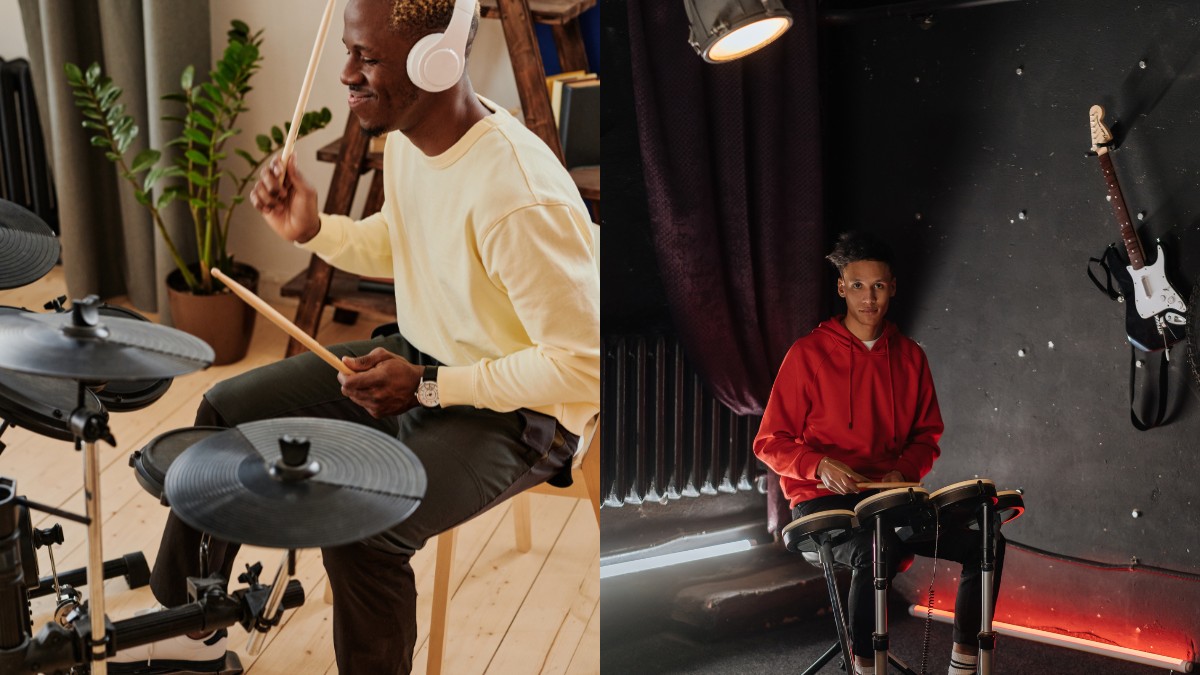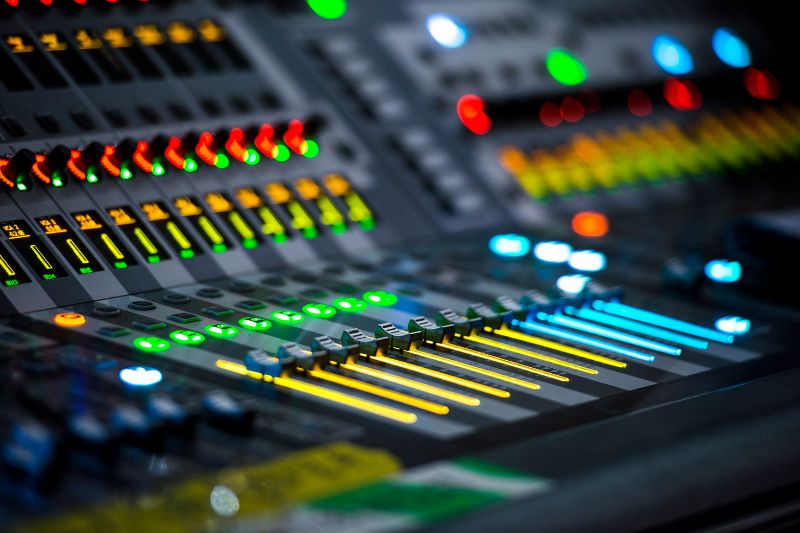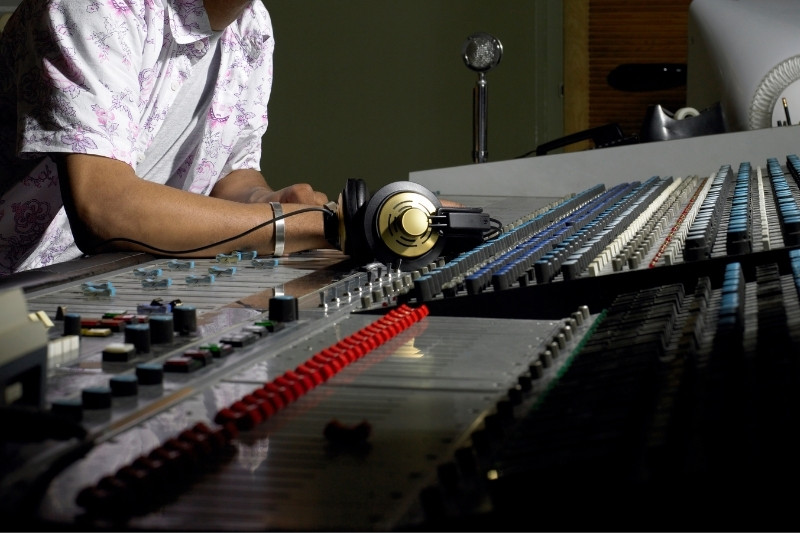What is an 808?

The term 808 refers to the TR-808, a popular drum machine originally produced by Roland between 1980 and 1983. 808 is also the name given to a specific type of kick drum sound with very strong low-end and unusually long decay that was featured in the TR-808 and appeared in countless hip-hop records.
The TR-808 was a complete drum machine with all kinds of sounds, from kick drums and snares to hi-hats and a cowbell. Today, the classic TR-808 sample collection is still hugely popular. Modern-day DAWs such as Ableton Live, for example, feature a built-in high-quality recreation of the TR-808 sounds.
However, the sub-heavy, long-sustain kick drum sample of the 808 has always had a special place in the hearts of hip-hop fans, beatmakers, and rappers. In the music production world, the term “808” is now more commonly associated with this particular sound than with the TR-808 drum machine itself.
Ever since it first appeared in the early 80s, the 808 has made its way into countless popular songs in and outside of hip-hop. More recently, it has been at the very core of trap music.
Contents
At a Glance
- The term 808 references Roland’s TR-808 drum machine, which was created between 1980 and 1983. 808 is also the moniker given to a certain sort of kick drum sound with a very strong low-end and particularly extended decay.
- Some examples of 808s in popular music are “Paul Revere” by the Bestie Boys, “I Want To Dance With Somebody” by Whitney Houston, “Xtal” by Aphex Twin, and more. (video examples below)
- The evolution of the 808 gave way to different types through the years which were processed or synthesized, resulting in distinctive 808 sounds: the classic 808, the 808 FX, the saturated 808, and the distorted 808.
- The way to create your own 808 sound is by using a synthesizer (analog or digital) with a sinewave oscillator and a pitch envelope. Naturally, most producers tweak the original sound to make it unique.
Examples of 808s in popular music
The Beastie Boys were one of the earliest hip-hop acts to understand the potential of the 808. While the sounds of TR-808 had already appeared in numerous hip-hop singles, it wasn’t until the release of “Paul Revere,” in 1986, that the long decay of the 808 kick drum took the spotlight. The beat of Bestie Boys’ hypnotic “Paul Revere” relies so heavily on the 808 that it almost doesn’t need any other sounds.
One year later, in 1987, the 808 reached the mainstream pop scene with Whitney Houston’s classic “I Wanna Dance With Somebody.” In this example, the 808 kick drum is slightly more discreet and used as a bass drum instead of a kick drum. The TR-808 rimshot sound is also heavily featured in the track.
Outside of hip-hop and pop music, the iconic electronic producer Aphex Twin proved that the 808 could be used to chill and not just to dance. His seminal 1992 track “Xtal” combines a muffled but hard-hitting 808 with an eerie atmosphere and vinyl-like textures to create an irresistible sonic landscape:
Arguably one of the most ingenious 808 fans, hip-hop legend Kanye West was one of the first popular musicians to use the 808 as a pitched instrument. His 2008 single “Love Lockdown” takes the power of the 808 to a whole another level by sampling it in different pitches and creating a hook that still sounds fresh today.
Perhaps more common than ever now, the 808 continued to take the world by storm after the appearance of trap music. Travis Scott is far from being the first (or only) trap rapper to rely heavily on the 808, but his song “Highest In the Room” makes for one of the finest examples of a trap-music hit:
Types of 808s
The evolution of the 808 sound is fascinating. While the original TR-808 kick drum was the sample that gave way to every 808 there is, today there are various types of 808s available to producers. Most are either the result of processed 808 samples or synthesized 808 sounds, but they all have a distinct vibe.
The classic 808
Phat, low frequency-based, and extremely hard-hitting, the classic 808 is still one of the best 808s around and can be used to great effect to create simple bass lines.
The 808 FX
A classic 808 sound that was pitched down, extended, and slightly modulated, the 808 drop is another familiar sound rooted in the original TR-808. It’s not so great for beats, but perfect for drops and introducing new sections of a song.
The saturated 808
As the name implies, the saturated 808 is a classic 808 that was processed by a saturator audio effect. What makes it special is that the distortion of the saturator adds a few mid-frequency harmonics to the sample, which causes the 808 to sound beefier.
The distorted 808
An even beefier version of the saturated 808, the distorted 808 is the wildest, punchiest, and most violent version of the classic 808. It’s processed by a distortion audio effect and compressed to the max to hit that “Loudness-War” level of volume!
How to make original 808 sounds
Ever since the 808 came into the scene, it’s been mainly used as a sample. Whether producers have a TR-808 or simply download an 808 sample pack, they tend to use 808s, sound-designed by others in their productions, and later tweak them using sampler instruments and various audio effects.
But is it possible to make an 808 kick drum sound out of nothing? Sure! All you need to create your own 808 sound is a synthesizer (analog or digital) with a sinewave oscillator and a pitch envelope. This is how you do it, step by step:
- Select a simple sinewave and turn the octave down until it plays a sub-bass frequency.
- Drag the attack and sustain down to zero and increase the decay until the sound lasts for as long as you’d wish your 808 to last. Optionally, you can add some release for a more fluid feel.
- In the pitch envelope section, select an initial pitch value of +12, drag the attach down to zero, and go for an extremely short decay (around 350ms or less). This will create the kick-like transient that makes the 808 pop once it hits.
- Add some effects. Unless you’re working with a very powerful synthesizer, your 808 sound will need some volume and light saturation to cut through the mix. To preserve the sonic integrity of your 808, use a transparent compressor (your DAW’s built-in compressor should do the trick).
Conclusion
The smooth-singing style of the crooner; the scratchiness of an amplified guitar; and the reverberated clap of the 80s: all these sounds have made their way into the history of music, and the 808 kick drum deserves to be among them.
In music production, few samples have been more used, chopped up, reinvented, and resampled than the original TR-808 kick drum. It has inspired countless artists since the early 80s and I’m pretty sure it will continue to do so in the future.
Featured Image by: Roland_TR-808_&_909.jpg: Brandon Danielderivative work: Clusternote, CC BY-SA 2.0, via Wikimedia Commons







